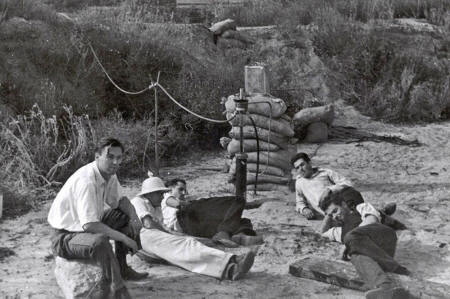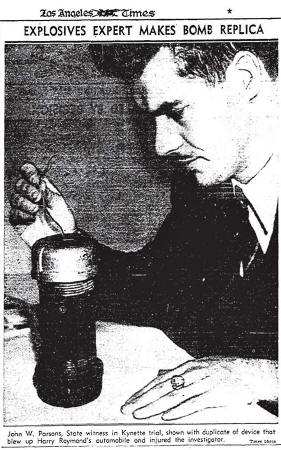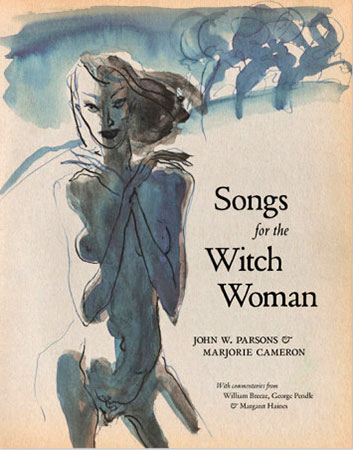|

by Olivia Solon
23 April 14
from
Wired Website
Spanish version
Parsons came to believe in
magic,
a force that he felt
could be explained
through quantum physics
Jack Parsons was a founding member of NASA's Jet Propulsion Lab
(JPL),
with some crediting him as being one of the "fathers of rocketry"
and others joking that JPL was actually Jack Parsons' Laboratory,
but you won't find much about him on NASA's websites.
Parsons' legacy as an engineer and
chemist has been somewhat overshadowed by his interest in the occult
and, and has led to what some critics describe as a rewriting of the
history books.
"He's lived in the footnotes since
his death. He's a forgotten figure," says biographer George
Pendle, author of
Strange Angel - The Otherworldly Life of
Rocket Scientist John Whiteside Parson
(Jack's full name).
George Pendle did an
"archeological dig" into Parsons' life after finding a mention of
him in a science book.
"The more I dug, the more bizarre
and extreme the story seemed."

GALCIT Group members
in the Arroyo Seco, November 1936.
L-R: Rudolph Schott,
Amo Smith, Frank Malina, Ed Forman, and Jack Parsons
NASA/JPL
In short: Parsons played a critical role in the formation of rocket
science and was instrumental in building the rockets that were
eventually used in the Space Race.
However, he also believed in magic, was
involved in the early stages of Scientology and had an extremely
colorful sex life.
For that reason, Pendle speculates,
Parsons' was a figure who didn't fit into the mould of the
Industrial Complex.
"Wernher von Braun - a former Nazi -
was much a much easier fit than Parsons," says Pendle. "A lot of
people would be shocked to find out that the space program was
founded by a man who held orgies in his Pasadena mansion."
Early chemistry
experiments
Parsons' interest in chemistry stemmed from his teenage years when,
inspired by space travel found in science fiction literature, he
started amateur rocket experiments with a school friend called
Edward Forman.
He later studied chemistry and high
school and took a holiday job at the Hercules Powder Company, where
he got to handle a wide range of explosives.
After school, Parsons was keen to access the rocketry facilities at
Caltech but his academic ambitions had been plagued by financial
difficulties. He and Forman ended up teaming with a PhD student
called Frank Malina to apply for funding from the university
to explore rocketry. They didn't reveal their ambition to develop
rockets for space exploration as this was, at the time considered to
be a science fiction.
At the university's Guggenheim
Aeronautical Laboratory, the trio collaborated on developing rockets
in a creative and liberal environment as members of the GALCIT
Rocket Research Group.
The group - which increased in numbers over the next few years - set
about developing a static rocket-motor before moving onto working
rockets.
The team became known as the "Suicide
Squad" on campus because of how dangerous their experiments were,
but eventually had success in building a static rocket that could
burn for more than a minute.
Esotericism
In the late 1930s, Parsons started to develop an interest in
esotericism, attending something called
The Gnostic Mass at the Church of Thelema.
Parsons came to believe in magic, a
force that he felt could be explained through quantum physics, as
espoused by Thelema's founder
Aleister Crowley.
"He was good with things that went
boom - so au fait with rockets and explosives," says Pendle.
As Parsons' interest in the occult
developed, his colleague Malina approached the National Academy of
Sciences for funding into "jet propulsion" as a means for developing
more nimble aircraft.
The team was granted $1,000 (£595 at
today's exchange) - the first government-funded rocketry research
group in history.
A quarter of the funding had to go
towards repairing damage to Caltech buildings caused by the group's
experiments and the group was eventually forced to relocate to some
iron sheds in the Arroyo Seco canyon, where they were closely
watched by the FBI which was keen to make sure that no political
extremists were accessing the explosives.
It was here that the Jet Propulsion
Laboratory would be founded.
One of the group's key innovations was developing Jet-Assisted
Take Off (JATO)
engines for the US Air Corps, with Parsons developing a restricted
burning solid rocket fuel that was stable enough to be stored
indefinitely.
The engine technology and fuel were
commercialized through a company called Aerojet, where Parsons
became project engineer. Versions of this fuel was eventually used
by NASA in the Space Shuttle as well as in military ballistic
missiles.
Hedonistic
Pasadena lodge
At the same time - 1941 - Parsons started to have a sexual
relationship with his wife's Helen's 17-year-old sister Sara -
something that was encouraged by his church. His wife started a
relationship with one of the church's most senior members, Talbot
Smith.
The four of them, along with other
Thelemites ended up moving into a
large house together in Pasadena.
Drugs flowed freely, as did sexual
partners. The lodge attracted negative attention, with the police
and FBI receiving allegations that it played host to a cult involved
in sexual orgies and black magic - although upon investigation, it
was deemed not to represent a threat to national security.
The US government heard that Nazi Germany was developing the V-2
rocket and so gave the GALCIT rocket research group - now without
Parsons - a grant to develop rocket-based weapons and the group was
renamed the Jet Propulsion Laboratory.
At around that time Parsons was expelled
from Aerojet by new majority shareholders who disapproved of his
"unorthodox and unsafe working methods".
Parsons and Forman moved onto found the
Ad Astra Engineering Company.
In 1945, science fiction writer - and later the founder of
Scientology - L. Ron Hubbard
moved into the Pasadena lodge. Sara took an interest in Hubbard,
which made Parsons jealous. He developed a deeper interest in
witchcraft and the darker side of magic, becoming fascinated by
poltergeists and ghostly apparitions.
In a bid to find conjure up a new lover,
he took part in extraordinary rituals where he would masturbate onto
magical tablets to the sound of music.
"After his girlfriend ran off with
Hubbard, he decided to create his own girlfriend and summon an
elemental," explains Pendle.
Poetry for his
'elemental'
After one such ritual in 1946, Parsons decided that he had managed
to conjure up his perfect woman.
So when he came into contact with
Marjorie Cameron, he was convinced she was the one.
"He felt as though his elemental had
arrived," says Pendle.
Cameron had no idea that she had been
"invoked" in this way. She became his muse and was the subject of a
book of poetry Parsons wrote at the time.
"When you think about scientists,
you don't think of them as necessarily being fun or having a
creative side. But Parsons saw himself of being at the end of
the line of a group of scientists stretching back to Newton, who
saw himself as a natural philosopher," explains Pendle.
"Newton wrote about alchemy. Poetry
used to be part of what the scientist was. He was a renaissance
man with a whole swathe of interest."
When Parsons worked on his rocketry
experiments in the desert he would recite a pagan poem to Pan.
Pendle doesn't see this as particularly
strange, saying,
"They were all young guys, it would
have been like going into a huddle and shouting the name of your
team."
Parsons' financial fortune fell apart
after he invested his life savings in co-founding a company with
Hubbard and Sara - his ex-girlfriend and her current primary
partner.
Hubbard convinced Parsons he was going
to buy yachts and resell them at a profit, but this never happened.
Parsons lost the vast majority of his money in the scam, the company
fell apart and eventually Hubbard and Sara went on to found
Scientology together.
Shunned in the
Cold War
Parsons remained a specialist in rocketry and was often called as an
expert witness in police investigations involving explosives.
"He was good with things that went
boom - so au fait with rockets and explosives," says Pendle.

Jack Parsons Jack Parsons
Parsons was called as an expert witness in bomb cases
Los Angeles Times
As the Cold War set in, any academics suspected of being communist
sympathizers were frozen out.
Parsons and many of his colleagues lost
their security clearance, leaving him unemployed. He found himself
earning money as a manual laborer, a hospital orderly and a car
mechanic. Having been pushed out of science, Parsons became even
more deeply entrenched in the occult.
He ended up applying his skills to create pyrotechnics and
explosives for the film industry. Just before a planned trip to
Mexico in 1952, Parsons - who was 37 - received a large order of
explosives for a movie.
While preparing the order, there was an
explosion involving mercury in which Parsons suffered fatal wounds -
some of his friends suspected a state-sponsored conspiracy although
it was ruled an accident.

Fulgur Press
To mark the centenary of Jack Parson's birth in 1914, Fulgur Press
is publishing a collection of Parsons' poems -
Songs for the Witch Woman
- which he wrote about Marjorie Cameron.
It provides an intimate glimpse into the
final years of their relationship which was cut short by his
untimely death. Cameron provides the illustrations.
"In the poems, he's writing to what
he saw as a magical creature," explains Pendle.
"Parsons uses imagery that is pretty far out," says Pendle,
mentioning a "vision of a girl and goat dancing together in a
satanic ritual", where the girl is more fearsome than the goat
she's dancing with.
"This is how he saw his relationship
with Cameron. She was a girl he'd summoned but he was also
terrified of her."
Many of the poems are,
"about a hidden world beyond the
view of normal mortals", Pendle says.
"Parsons had his rocketry as well as
his normal life. He discovered other worlds by imagining going
in a rocket to the Moon. He wanted to explore this new frontier.
He saw both space and magic as ways of exploring these new
frontiers - one breaking free from Earth literally and
metaphysically."
In the end it was Parsons poetry and
other interests that ended his career in rocketry.
"The government doesn't really want
any people with quirkiness," says Pendle. "With all of the
rumors about the Pasadena lodge, the magic and chanting poems at
rockets, he couldn't fit into a government job."
In Pendle's view, Parsons is the
founding father of rocketry and should be recognized as such.
This sentiment is echoed by a number of
his colleagues, including Wernher von Braun and Malina, who
felt as though his contributions to American space technology had
been neglected.
"If you are looking for a conspiracy
it's not his death, it's why he's been wiped from history. There
is much more room for mavericks now than there was in the 1940s
and 50s."
"He's not really mentioned in a tour
of the Jet Propulsion Laboratory, there's no mention of him as a
founder," continues Pendle. "He may be referenced briefly in the
footnotes, but it's the occult side of his life that keeps his
light burning, not the science."
Wired.co.uk contacted JPL and we asked
whether Parsons had been written out of the history books.
Historian Erik Conway said:
"Jack Parsons is included in history
books and other venues, and in fact, his role is discussed in
the JPL-involved standard history,
JPL and the American Space Program
by Clayton R. Koppes.
Parsons was one of the original
founders of JPL. He was the team's chemist and developed the
first castable solid propellant used to power aircraft."
|



